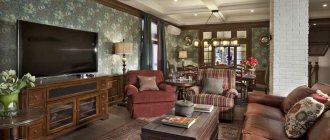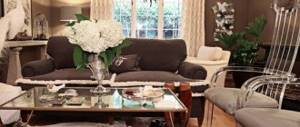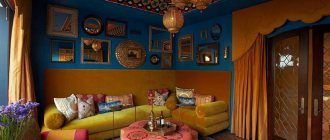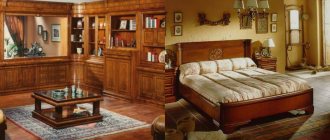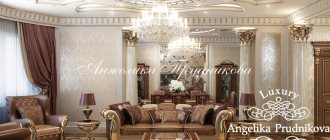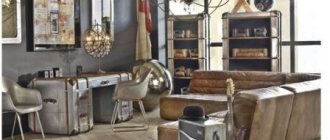What is chinoiserie style?
White porcelain with blue painting.
Panel or wallpaper with exotic birds on flowering rose or magnolia bushes.
Carved and lacquered chests of drawers and file cabinets with gold inlay.
Chairs and armchairs with carvings and decorative paintings.
The listed elements are found in various interior styles, from ancient classic to modern, but they have common roots - this is the heritage of the chinoiserie style.
The Russian name “chinoiserie” comes from the French language, where the word Chinois means Chinese
, and the full sound of Chinoiserie came from the French vernacular, which, when closely translated into Russian, means Chinese.
In a broad sense, under the general name chinoiserie refers to different phenomena: a fashion trend, the borrowing of customs and culture, interior style, architectural style, landscape design, plots and drawings, drawing techniques, furniture and individual elements of furniture decorations. Although the name chinoiserie is addressed to China, in reality, both Japanese and Indian goods fell under the common Chinese name. And the confusion about belonging to a particular country is connected with the history of style, which mixed truth and fiction, nobility and outright deception. Let's start in order with history.
History of the chinoiserie style
The concept of chinoiserie originated around the 17th century as a name for a general fascination with oriental designs and objects. But this fact was preceded by a long historical period.
Background
The conquest of Alexander the Great is considered the start of Europe's knowledge of Asia. Afterwards, the period of development of overland trade along the “Great Silk Road” began. The origin of the future chinoiserie style is considered to be the period of the high and late Middle Ages, from approximately the 13th to the 16th centuries. At this time there were many events: the fall of empires, the creation of new states, the development of international trade and the discovery of new lands. The period from the 15th century to the 17th century is called in history the period of “Great Geographical Discoveries”. At this time, Christopher Columbus and Ferdinand Magellan traveled, creating new sea routes. Travelers discovered new lands, and subsequently created new trade routes, bringing new knowledge, technology and culture.
Marco Polo 13-14th century.
One of the most influential people who contributed to the spread of Asian and Oriental culture in Europe was Marco Polo. Marco Polo was an Italian merchant and traveler; he was not the official discoverer of new lands, but discovered knowledge about Eastern and Asian countries: Armenia, Iran, China, Kazakhstan, Mongolia, India, Indonesia and others - their history, culture, traditions. The history and account of his travels were recorded by a man named Rustichello of Pisa, while they were imprisoned together in a Genoese prison. From Rustichello's manuscripts they later published the book “The Book of Wonders of the World” or another name for the book “The Travels of Marco Polo”:
The book about the travels of Marco Polo was on board the ship of Christopher Columbus during his travels in search of a sea route to India. The events of history, culture, morals and traditions described in the book formed the primary image of China and the eastern countries - mysterious, enigmatic, noble. Some historians are of the opinion that the Chinese gardens described in the book became the primary impetus for Europeans’ interest in landscaping gardens and parks in an oriental style. And many of the European monarchs who ruled at that time tried to instill in their countries the principles of unconditional power according to the Chinese-Mongolian model, which was also described in the book of Marco Polo.
Peak of popularity
The beginning and peak are at the end of the 16th century, 17th and 18th centuries. The spread of Chinese objects in Europe took place thanks to diplomats and traders. Wonderful things made in an incomprehensible way from unknown materials: silk, porcelain, lacquered furniture, clothing, paper, tea, spices - delivered to Europe by East Indian ships. First, the collecting of oriental rarities by the nobility became fashionable, then collecting grew into the formation of a lifestyle and a separate style - early chinoiserie.
Early Chinoiserie
- a passion for East Asian designs, in architecture and interiors using original items produced in China, Japan, Indonesia and imported to Europe. The period of early chinoiserie dates back to the 17th century. The end of early chinoiserie is considered to be the moment when craftsmen in China and other eastern countries began to produce objects oriented towards European tastes, with a change in typical ethnic oriental designs.
With the popularity of Chinese designs comes a wave of imitation and repetition of technologies by European masters, which is called late chinoiserie or simply chinoiserie.
Late Chinoiserie or Chinoiserie (without additional words)
- the production of objects and the use of designs in the style of early chinoiserie, produced by European craftsmen with repetition or modification of technology. This period occurred approximately at the end of the 17th - beginning of the 18th century. To accurately restore technology, European craftsmen and architects were sent to Asian countries to study and gain experience. There were also options for inviting Asian masters to Europe. For many historians and specialists, it is this understanding that is the truth in defining what chinoiserie is as a style. That is, chinoiserie is objects made by European craftsmen in the Eastern tradition, with their own additives and vision, and imported Eastern goods oriented towards European tastes, sometimes with European designs and subjects.
France became the leader among European countries in popularizing chinoiserie, and the main activist, and modern style influencer, was King Louis XIV of France, under whom the first wave of popularity in the use of oriental designs in interiors and architecture appeared. Subsequently, a number of chinoiserie elements became a natural part of Louis XIV's own style.
Salon of Louis XIV, Chateau de Chenonceau, Loire region, France
A famous architectural structure in the Chinoiserie style under Louis XIV was the Porcelain Trianon, a palace with a short history. The palace was built in 1670 as a gift from the king to the favorite Marquise de Montespan, and was dismantled seventeen years later in 1687. According to one version, the palace was dismantled after the change of the king's favorite; according to another version, the structure turned out to be impractical and quickly collapsed.
The interior painting was in keeping with the spirit of the early Chinoiserie style - the white plaster walls were painted with blue ornaments, imitating the painting of Chinese porcelain of the Ming era, and the furniture was also painted. It is believed that the idea for the construction of the porcelain palace was another building - the Nanjing Pagoda. Evidence of it remains an engraving in Nieukhof’s book, which was considered at that time one of the wonders of the world:
The Porcelain Palace and Pagoda of Nanjing marked the beginning of the process of creating a string of buildings and interiors: porcelain rooms, Chinese rooms, Chinese tea houses, pagodas - built in Europe in the 17th and 18th centuries.
Installations with a collection of Far Eastern objects and decorations were called “lacquer rooms” and also “Chinese rooms”. Lacquer - because lacquer was considered an indicator of luxury, almost the same as gilded decor and painted porcelain. Rare masters were involved in the creation of such rooms, and only monarchs could afford the maintenance. The fashion for lacquer rooms came from France and Germany, and reached Russia.
The first lacquer room appeared in Russia under Peter I in 1720–1722 in the Monplaisir palace in Peterhof; its creation was led by the Dutch lacquer master G. Brumkorst.
Under Empress Catherine II, the following appeared: the Chinese Palace in Oranienbaum, the Chinese Cabinets in Peterhof, the Chinese Hall in Tsarskoe Selo, as well as the Chinese mezzanines in the Hermitage:
Room of the Chinese Palace in Oranienbaum
In the interiors of English houses, carved lacquered furniture was of greatest interest. The presence of lacquered furniture in the interior is still considered a mandatory attribute of English styles:
Office-office, around 1730, China. Illustration: Victoria and Albert Museum, UK
Also, a separate fashion trend has spread - landscaping gardens and park architecture in the Chinese style. The Great Pagoda, or “Great Pagoda”, built in 1762, is now one of the architectural landmarks of London:
The Great Pagoda at the Royal Botanic Gardens, Kew. Illustration from the Royal Botanic Gardens website: www.kew.org
Even today, deliveries from China to Europe, Russia, or Belarus are a troublesome and costly matter. And in the 17th and 18th centuries, this event was much more expensive, plus it was also more dangerous. Therefore, items brought from China and Japan were conventionally divided into expensive and very expensive. And the local craftsmen of that time had a natural desire to join in the popularity. They produced similar stylized items or, frankly, counterfeited Chinese ones. But not everything turned out to be simple. The secrets of technology were kept secret, and raw materials were often not available. Some secrets were unraveled and restored, or replaced with their own developments. The practice of ordering semi-finished products from China and Japan for subsequent refinement in Europe has become widespread. They did this with furniture, porcelain, and silk.
It was a fashionable practice to invite Eastern masters and architects, or send Europeans to China and Japan for knowledge. As a result, all sets of events gave rise to a large number of new objects, production methods, technologies, and subsequently brands that are known and used to this day.
A famous example is the English furniture maker Thomas Chippendale, who used chinoiserie designs that came into fashion in the design of his furniture. Later, furniture based on Chippendale's designs received its own separate style direction.
In the second half of the 19th century, the chinoiserie style in Europe reached the pinnacle of its development.
The decline of chinoiserie popularity and rebirth
People's taste changes, transforms, fades, and returns again. Around the 19th century, interest in chinoiserie and Asian motifs waned. The direction of people's thoughts towards widespread industrialization did not coincide with the motives of chinoiserie. And the motifs themselves hardly resembled the designs of their “ancestors”; this fact is clearly visible in the archival advertising leaflet of a furniture salon inviting a sale of furniture from the Chinese collection:
Advertising leaflet for a furniture salon. 1895 Illustration: www.bl.uk
In contrast to man-made themes, a movement is emerging to revive the culture of natural beauty in interiors. Enthusiastic designers of the Arts and Crafts Society and their inspirer William Morris decorate their houses with paintings of flowers, blooming gardens with birds of paradise, very similar to chinoiserie style paintings:
Morris's room. Illustration: Victoria and Albert Museum, UK
It would be wrong to talk about the complete decline of chinoiserie. Because the trace left by design and technology that came to us from the mysterious east has not disappeared without a trace to this day. Many interior styles of the Chinoiserie era and their “descendants” inherited oriental design elements:
Georgian style - carved and lacquered furniture, wall decor. Victorian style - expressive wall decor, furniture, porcelain decor.
Colonial style - without outlandish oriental decor, antique chests of drawers and file cabinets, will not be colonial at all.
Also, many significant and inconspicuous elements from the Chinoiserie style were transformed into other styles: Art Nouveau, Art Deco, Empire.
If we add all the achievements of Eastern civilization to chinoiserie, the list will be quite impressive. Let's consider the discoveries that came to Europe during the birth of the chinoiserie style, and which we still use today.
LiveInternetLiveInternet
Quote from Milendia_Solomarina
Read in full In your quotation book or community!
Interior style CHINOISERY
Many times in my work I had to bring to life interiors with oriental motifs, and sometimes even create objects (painting chests of drawers and boxes) or paint interior paintings in the Chinese style. Today I would like to write about combining Chinese interiors with classic Western ones. For such a mix of styles, there is the term Chinoiserie, chinoiserie (from the French chinois - Chinese), or Chinese - the use of motifs and stylistic techniques of medieval Chinese art in European painting, decorative and applied arts, costume, and in the design of landscape gardening ensembles of the 18th century
. Chinoiserie is a style movement that developed as a branch of the Rococo style from the 1720s, one of the types of Orientalism and exoticism. After the grandeur and splendor of the Baroque with open representative spaces, in Rococo with its love for luxurious and at the same time comfortable surroundings, a special type of chamber interiors was created. In the Chinese style, mainly small men's offices, boudoirs, living rooms, and, less often, bedrooms or dining rooms were decorated. These interiors, along with authentic Chinese items, were decorated with European paintings, panels, tapestries, and fireplace screens with Chinese motifs. Movable screens have appeared in the interiors, visually changing the space
.
In the 1730s, French furniture makers, the Martin brothers, invented colored varnishes similar to Chinese ones, and from that time on, the chinoiserie interior was enriched not only with black-red-gold chests of drawers and cabinets, but also with pearl-blue and olive-green furniture inserts and panels with gold powder. . The general atmosphere of refined luxury was complemented by all kinds of porcelain products, authentically Chinese and European (Delphian faience, Meissen porcelain).
.
The use in decoration of images of dragons and snakes, phoenixes and birds, full of symbolic meaning, pictures of feasts and hunting, as well as landscape sketches and other exotic motifs was another distinctive feature of this style. The images were often of a benevolent nature: a blooming peach tree or rock - a wish for longevity, bats - happiness, peony flowers - nobility, a dragon - power
. Many famous masters of that time worked in chinoiserie: lovely Chinese women wandered around in the canvases of F. Boucher, “Chinese” furniture by French masters M. Carlin, P. Mijon, E. Michard was extremely popular. Chinese motifs - all kinds of geometric wickerwork and legs in the form of a bird's paw squeezing a ball - decorated the furniture of the English master Thomas Chippendale. An original and inventive, chamber style of aristocratic living rooms and boudoirs, Rococo easily absorbed any fashion trends, but Chinoiserie was not an exclusively Rocaille phenomenon.
.
A characteristic feature of chinoiserie was the luxury of the materials used. In Europe, back in the 17th century, both embroidered and painted Chinese wallpapers, which were very expensive, were highly valued. They were brought from China through the East India Company. The traditional technology of processing Chinese silk to make wallpaper was quite labor-intensive. Impregnated with a substance reminiscent of starch, the fabrics were pulled between hot rollers, which made it possible to glue the threads together and compact them.
.
Thanks to this treatment, Chinese silk fabrics acquired a surprisingly soft shine. Paints for painting were made from malachite, lapis lazuli and other minerals. Later, wallpaper in the chinoiserie style began to be produced in Europe. Usually, Chinese or pseudo-Chinese silks were used to cover the upper part of the wall, with a wooden or ceramic plinth running underneath
.
With the emergence of interest in tea drinking in Europe, unique structures called “tea houses” or Chinese pavilions began to appear in palace and park ensembles. Perhaps the first experience of this kind was the Chinese village built in the 17th century at the Drottningholm Royal Palace in the vicinity of Stockholm. In 1762, the British architect William Chambers erected the graceful 50-meter Great Pagoda in the Royal Botanic Garden (Kew Gardens near London) for the entertainment of the public. One of the most striking examples of a “tea house” is the pavilion in Sans Souci, the residence of Frederick the Great (architect I. G. Bühring, sculptor I. P. Benkert).
.
In Russia, the passion for Chinese style was embodied in the creation of the Chinese Palace in Oranienbaum. The Chinese palace was created in 1762-1768 under the leadership of the architect Antonio Rinaldi. Rinaldi was known as a master of the pseudo-Chinese style. To accommodate guests of the imperial residence in Tsarskoe Selo, he copied engravings that belonged to the empress and built an entire Chinese village, which included, in addition to the houses themselves, a number of fancy bridges in the oriental spirit and even a playful imitation of a pagoda
.
During the Art Deco era, chinoiserie was again in demand. This is especially noticeable in the decorative and applied arts of the 1920-1930s: in the form of ashtrays, lamp shades, inkwells, as well as in the design of porcelain tableware. The leader of the porcelain industry, which used chinoiserie aesthetics in the 1920-1930s, was the Hungarian company Herend
.
The main colors of English lacquerware were black, red, yellow, green, brown, tortoiseshell and, much less frequently, blue. Although Chinese designs were in great fashion, products of European origin were usually decorated to suit European tastes. The masters were more likely to be inspired by foreign motifs, Chinese or Japanese, rather than copy them. Given these stylistic differences, it is easy to distinguish between original 18th-century oriental furniture and European interpretations of lacquerware and chinoiserie.
.
Modern British, Americans and French are too sensitive to the continuation of the traditions of their ancestors, convinced that the classics of the 18-19 centuries or art deco are the best options for home furnishings. Mandatory in the decoration of a traditional Western interior to this day are luxurious Chinese fabrics, high-class paintings and finishing materials, as well as furniture with inlays (intarsia or marquetry) and, of course, Chinese porcelain
.
13.
14. .
.
Below I post some pictures from my own European-Chinese projects
3.
4.
5.
6.
7.
8.
Series of messages “Interior projects”:
Part 1 - My apartment decor in London Part 2 - My bamboo interior No. 1. ... Part 12 - Interior of an English house in the style of vintage neoclassical Part 13 - My vintage for today. MK bookcase and suitcase. Part 14 - CHINOISIRE interior style Part 15 - Design of penthouses in London Part 16 - Oriental style and vintage in the interior. The embodiment of MK. ... Part 18 - Mezzanine in living rooms with high ceilings and mezzanine Part 19 - Minimalism in a London 2-level apartment. Part 20 - Interiors of a Victorian mansion. How the project developed.
Series of messages "Interior Design Styles":
Part 1 - Interior Design Styles. Baroque and more. Part 2 - Loft style in English interior... Part 20 - Boutique hotel or designer hotel. Part 2. Part 21 - Boutique hotel or designer hotel. Part 3 Part 22 - CHINOISERY interior style Part 23 - French house: “Crystal ringing” Part 24 - Interior of houses with thatched roofs in rustic style ... Part 35 - Stroganov’s mansion and palace in watercolors. Part 36 - Moscow designers are the best. Part 5. Neo-Baroque and Neo-Rococo. Part 37 - Interiors of a Victorian mansion. How the project developed.
Porcelain
“In 1171, the Egyptian Sultan Saladin sent forty “Chinese products” to the Sultan of Babylon; Soon, the crusaders returning from Egypt spoke about the splendor of this gift.” Note from Wikipedia.
Porcelain appeared in China approximately 600 BC, and the production of white porcelain, with a composition similar to Chinese, was established only in the 18th century in Europe. Porcelain tableware and porcelain products are the most significant heritage of Chinoiserie. It is not without reason that the word China is translated from English simultaneously as China as a country, and porcelain or porcelain products, as a designation for an object made of porcelain. Initially, porcelain was supplied from China as finished products decorated with underglaze painting with cobalt blue; this technique was subsequently repeated by European masters:
The type of Russian porcelain painting craft - Gzhel, also continues the traditions of chinoiserie.
Interesting historical fact:
“Porcelain production in China in the 17th and 18th centuries was divided into export and domestic. The approximate ratio of export and domestic manufactories was: for one export manufactory there were twenty domestic ones, intended to serve the imperial Beijing court. The Beijing court received porcelain of the highest quality “first” and “second choice”, while defective lots were returned to the manufacturers. But there was no accounting of rejected porcelain. The people responsible for the delivery of porcelain at court manipulated these supplies during the 18th century and resold defective imperial porcelain to Europeans. Thus, products with imperial stamps sometimes arrived in Europe. The East India Companies, which were engaged in buying items in bulk and shipping them to the West, also made huge profits, despite the difficulties of this enterprise and the bribery of Chinese officials and merchants." Note from the book
:
Chinoiserie in China. M.A. Neglinskaya
The origin of the style
The style originated in the 17th century in France, as an offshoot of the then dominant Rococo, thanks to the East India Company, as a result of which many Chinese items came to Europe. The word chinoiserie itself, translated from French, means “Chinese”; perhaps, in French everything sounds more sublime.
In those days when luxury ruled the roost, emphasizing your wealth was not considered bad manners. In those days, beautiful sets did not gather dust on the shelves of sideboards. People drank wine from gold and silver glasses, and with the advent of the tea tradition, they began to actively use elegant porcelain. Classic Chinese porcelain, white, with blue ornaments and images of exotic birds, was loved by all court residents.
Silk - silk panels - wallpaper
If porcelain became the true heritage of chinoiserie, then silk as a material is the heritage of the entire Eastern civilization. For our interior theme, we will highlight the use of silk for decorating rooms. This technology came to Europe at the same time as the popularity of chinoiserie. Hand-painted silk brought from China was used to decorate rooms and use it as upholstery for furniture.
In addition to the primary aesthetic qualities, silk panels also had a practical advantage - resistance to parasites. This fact gave silk an advantage over its competitor cotton fabric, before the active use of paper:
Fragment of a paper panel in the chinoiserie style. Made around 1800. Illustration: Victoria and Albert Museum archives, UK
Painted silk panels were the basis for the appearance of wallpaper:
Handmade panel studio MISHA WALLPAPER
Creating a chinoiserie interior
To recreate the atmosphere of traditional houses of the upper class of the 18th century at home, it is best to combine Chinese decorative elements with a classic interior style, favorably highlighting the simplicity and laconicism of forms. However, in some cases it is also possible to play on contrasts with modern minimalist interior design.
Spectacular lacquered screens
One of the easiest ways to add a touch of chinoiserie to the interior of a particular room is to use wooden screens with a black or brown lacquered surface, decorated with paintings with traditional Chinese motifs of natural landscapes or everyday life. Such screens, folding like an accordion, are ideal for delimiting space in the bedroom into a place for sleeping and reading or just spending quiet time. If you add a carved Chinese bedside table to the screen, you can achieve a very harmonious and stylish overall visual perception.
The lacquered screen looks quite stylish and unusual in a penthouse bedroom. It allows you to give such a modern interior the missing privacy and elegance.
You can also cover the entire wall behind the sofa in the living room with a painted screen, which will fully demonstrate the beauty of this Chinese interior design element.
Silk painted wallpaper in the form of wall panels
Chinoiserie in the interior of any room is perfectly realized with the help of wall panels with silk painted or embroidered wallpaper. Covering the entire surface of the walls with such wallpaper is often too expensive, and it doesn’t always look appropriate within this style, but selective decorative use of wallpaper in the form of panels immediately attracts the eye, and also solves the problem of stylish and elegant wall design.
The placement of such panels with a barely noticeable thin frame on both sides at the head of the bed is a bit reminiscent of the Japanese style in the interior, but still differs in the bright red color of the main wall. With this bedroom design, silk pillowcases with traditional patterns on decorative pillows, as well as bedside lamps reminiscent of floating Chinese lanterns, are a wonderful addition that emphasizes the chinoiserie style.
In a double children's or guest bedroom, you can combine silk panels with black and white Chinese motifs at the headboard with a carved table and a round red wall decor element between the beds. This will create the illusion of immersion in Chinese culture without using any other interior design items.
By combining a large pearl panel with birds and flowers depicted on it on the side wall near the bed with an iridescent silver canopy and antique wicker furniture, you can create a very sophisticated interior that is not overloaded with too bright and bulky decorative details.
Framing silk red Chinese wallpaper with carved gold frames and stucco and placing it on walls with classic white wood paneling complemented by columns with gold molding elements, you can instantly transform any room into a true Chinoiserie oasis.
Lacquered cabinets, sideboards and secretaries with gold painting
To create a chinoiserie atmosphere, you can use red lacquered carved cabinets and sideboards with gold painting in the form of traditional Chinese scenes in the design of the living room. Such eye-catching interior items look especially harmonious in tandem with silk wallpaper in muted tones with unobtrusive embroidery or painting, as well as classic furniture with laconic round shapes.
Beautiful carved brown or black secretaries with many compartments, covered with gold ornaments and complemented by brass elements on the outside, look very original. Such a secretary can be placed in the living room, library or bedroom, thus creating a compact, convenient and elegant workplace.
The simplest option for embodying the “a la Chinese” style is to add to a bedroom or living room, decorated in a classic style, a lacquered black or red wardrobe on high legs with a traditional Chinese culture circle pattern on two doors.
Despite the apparent exoticism, various decor options in the chinoiserie style fit quite easily into any interior based on the classics in one interpretation or another. To create a similar design at home, it will be enough to just add one element of “Chinese”, selected in accordance with the color scheme of the room or, on the contrary, completely contrasting in color, and intelligently “play up” it with small accessories.
Varnish and lacquered furniture
Just as porcelain in England became known as China, lacquerware became known as Japan, but lacquerware came from Japan and China at the same time. Europe became acquainted with them at the end of the 16th century, when cabinets with drawers, sideboards and chests began to be imported from China and Japan:
Illustration: Victoria and Albert Museum, UK
Varnishing in traditional Chinese and Japanese techniques is a complex process that can involve more than 30 stages of varnishing, with precise temperature and humidity.
Furniture was decorated in two ways: carving and surface painting:
The Chinese had a separate type of decoration - lacquer carving. Where the drawing was done in layer-by-layer alternation: patterned carving, polishing, painting, varnishing. No less famous are the red-lacquer Chinese products covered with complex patterned carvings, which are given a red color to the varnish by cinnabar, or mercury ore. In addition to multi-faceted relief carving, famous Chinese techniques include the finest polychrome and gold painting with varnishes on a black or colored background, inlay with mother-of-pearl, tin and silver.
In Japan, one of the most common methods is maki-e. The technique involves sprinkling gold or silver powder onto a varnished surface to create a pattern. Another type of Japanese decoration is kirikane (cut metal), in which the surface of the lacquer is studded with numerous, individually applied thin small squares of gold, silver or tin. The third type, hemon - inlay with metal plates, involves the use of thin metal sheets, randomly cut, and inserted into the varnish surface. Another inlay technique is raden, which uses mother of pearl, as well as pearls and ivory. The raden technique was also known to the Chinese; their varnishes, inlaid with pieces of iridescent blue and green mother-of-pearl, are of a variant that later became known by the French term lac burgautée. The Chinese used many additional materials for inlay, including jade, coral, ivory, and porcelain.
Illustration: Victoria and Albert Museum, UK
Lacquered furniture was highly valued in Europe. Imitating Chinese and Japanese masters, European furniture makers of the 17th century began to inlay their products with the same precious materials.
Lacquer from China and Japan was perceived as a mysterious and precious material, due to the fact that for a long time it could not be repeated or a high-quality substitute could be found. The secret lay in the main component of the varnish - the resin of the Lacquer tree ( Toxicodendron vernicifluum
), native to China, Japan and Korea. While the resin or varnish, as a raw material, was delivered to Europe, it dried out and became unsuitable for work. Before the advent of recipes replacing oriental varnish, the only option for interaction was the supply of finished furniture and, a little later, semi-finished products. In the 17th century, analogues of varnish with a different formulation were developed in European countries.
The fashion for lacquerware soon led to the spread of varnishing as a fashionable activity, especially in England, where it was called japanning.
In France, varnishing was called ouvrage a la Chine, translated as a product made in China.
Production of lacquered and carved furniture opened in Germany:
Lacquered table and chairs in chinoiserie style in a Chinese room. Nymphenburg Palace, Munich, Germany.
In Russia, they became acquainted with lacquered furniture under Peter I, when a gift from Emperor Kangxi was given: “many lacquered tables, chairs and small cabinets.”
Areas of use
The chinoiserie style became widespread in decorative and applied arts. The Chinese fever that swept France, England and Germany was especially evident in the creation of various accessories. Original fans and umbrellas with exotic patterns became an indispensable attribute of the life of every aristocrat. More and more new “Chinese” elements began to appear in homes in the form of porcelain figurines and vases.
At its inception, the pseudo-Chinese style was often used to decorate living rooms and boudoirs. Mobile screens were imported from China, characterized by a large amount of varnish and carved decor. Attempts to import varnish from China were unsuccessful due to the rather long delivery period. The creation by European furniture makers of their own version of Chinese varnish expanded the color range and made it possible to produce brighter shades. The fashion for interiors in the chinoiserie style appeared during the heyday of Rococo.
Fine hand-painted Chinese screen
The passion for Chinese flavor is reflected in the costume. The patterns of the fabrics changed, becoming brighter, and plot scenes appeared in the patterns. The main difference from Rococo was the color palette in the form of brighter plant motifs. The silhouette of the women's suit has changed. Dresses with lace sleeves gained popularity among Europeans, especially the French. The British liked straw hats.
On a note! Chinoiserie appeared in Russia during the reign of Peter I, who noticed the unusual style during his stay in Europe. The Chinese palace, which became a masterpiece of Russian art, is considered the most striking representative of that period.
Despite the fact that the appearance is not similar to the architecture of China, for Russians this monument has become the personification of Eastern culture. Also, buildings in the chinoiserie style were created in Tsarskoe Selo - gazebos and bridges.
Screens
Screens occupy an intermediate position between lacquered furniture and panels, as they combine both. But it still stands out as a separate functional decorative item. A screen was used to zone part of the room and create a personal, intimate space. Screens painted with various subjects were a separate piece of art:
The screen, as a design element, survived the craze for the Chinoiserie style, and began to be used as an ordinary piece of furniture, including in other styles not directly related to the East. And it is even more appropriate in all oriental, that is, oriental, interior styles.
A wardrobe is styled somewhat like a screen:
Handmade painting studio MISHA WALLPAPER
Interior in chinoiserie style
Chinese motifs - all kinds of geometric wickerwork and legs in the form of a bird's paw squeezing a ball - decorated the furniture of the English master Thomas Chippendale. An original and inventive, chamber style of aristocratic living rooms and boudoirs, Rococo easily absorbed any fashion trends, but Chinoiserie was not an exclusively Rocaille phenomenon.
In the 1730s, French furniture makers, the Martin brothers, invented colored varnishes similar to Chinese ones, and from that time on, the chinoiserie interior was enriched not only with black-red-gold chests of drawers and cabinets, but also with pearl-blue and olive-green furniture inserts and panels with gold powder. . The general atmosphere of refined luxury was complemented by all kinds of porcelain products, authentically Chinese and European (Delphian faience, Meissen porcelain).
Papier mache
Despite the French name, China is considered the birthplace of papier-mâché, where paper was invented. The first objects made of papier-mâché were discovered during excavations in China; these were armor and helmets.
With the popularization of varnishes during the heyday of chinoiserie, the direction of furniture production appeared. A mixture of paper and wood shavings was mixed with glue, then coated with multiple layers of varnish. Papier-mâché furniture was cheaper to produce and allowed complex shapes to be created. Active production of papier-mâché furniture lasted until the 20th century:
Illustration: Victoria and Albert Museum, UK
The modern Dutch studio Studio Job Gallery has continued the tradition and produces designer furniture from papier-mâché:
Studio Job Gallery Photo: studiojobgallery.com
The technology for creating composite materials has become the basis for the modern production of laminated chipboard and MDF materials.
Gardens and landscaping, parks, park architecture
The gardens described in the book of Marco Polo greatly inspired Europeans. The fashion for organizing and decorating parks in an oriental spirit, using oriental architectural details and buildings, has spread to almost all major European countries. But park ensembles in the chinoiserie style were organized on a particularly large scale in England. Park ensembles adapted to the local climate received the separate name “Anglo-Chinese park”:
Chinese Garden of Friendship, Sydney, Australia. Credit Wincliffe
Chinoiserie: style features
These distinctive features include:
- traditional Chinese garden stools that subtly emphasize the spirit of exoticism even in the most European interior.
- use of silhouettes of Chinese pagodas and ornaments with birds of paradise in the design.
- the presence of blue and white porcelain in the room. Freedom of style allows you to transfer such a pattern to absolutely any item.
- the presence of bamboo furniture (usually imitation).
- the use of the most characteristic element of Chinese interior design – a light screen. Even if such an item has no practical use, the screen perfectly copes with the role of a decorative accessory.
- introduction of characteristic ornaments and oriental motifs into the design. To create an interior in the chinoiserie style, wallpaper with images of exotic birds, sakura branches, dragons, etc. is selected. It is not uncommon for some moments from the life of the Chinese to be depicted on the surface (picking rice, glorifying the emperor, etc.)
- figurines with a characteristic oriental motif will be the final touch in creating a “pseudo-Chinese” interior.
At your discretion, you can use figurines of elephants, dragons, Buddha or any mythological creatures.
Chinoiserie designs and their descendants
Watercolor drawings of nature in Chinese art reflected the beauty and harmony of nature and man, the harmony of the masculine and feminine principles. Exotic birds, animals, climbing flower bushes - when you look at archival samples of panels painted using Chinese techniques, it’s hard to believe that these subjects are 700 years old, they are so closely similar to modern painting techniques, and at the same time, they are not similar to historical techniques Middle Ages:
Li Kan. Bamboo and stones. 1318, Metropolitan Museum of Art, New York.
In the products that traders brought from Asia, mini-scenes reflected scenes of life and historical events characteristic of the area from which the goods were brought. But later, the themes of the plots began to reflect Europeans and their way of life. At first, Asian masters reflected their look on Europeans, then, when a number of goods began to be produced in Europe, European craftsmen and artists were engaged in painting. These graphic images served, at the same time, as decoration and a source of information. Nowadays such execution would be called graphic content in decoration. One of the popular French historical textile brands, which actively used mini-plots, is described in the article: Wallpaper and textiles for the Provence style, Toile de Jouy motif.
Modern popular prints: flowers, flowering bushes and blooming gardens, birds on branches - these are the successors of oriental designs that once upon a time came to us with the chinoiserie style:
Wallpaper stylized as oriental hand-painted in the Atelier collection of BN International. Online store: www.oboivdom.by
Wallpapers and panels in the Christian Fischbacher collection of BN International. Online store: www.oboivdom.by
In minimalism
Modern minimalism requires emptiness and air, the absence of rough forms - harmonious and sophisticated patterns in chinoiserie designs will emphasize airiness and, if necessary, remove excessive visual poverty in a minimalist style interior.
That's all. What's in upcoming publications?
And new publications await you in the company secret section. And new articles about interior design, decoration, renovation.
Subscribe to notifications of new publications by email or on social networks:
| Add to our groups on social networks: |




